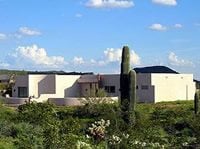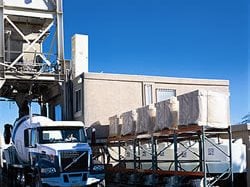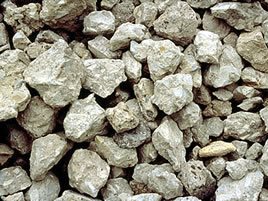- Is Concrete Sustainable?
- Green ideas for exterior concrete
- Green concrete floors
- Green concrete countertops
- Green concrete homes
- Urbanite: Repurposing Old Concrete
- Related Information:
- How decorative concrete qualifies for LEED credits
- Making concrete greener: Ten easy steps to greener concrete production
- Optimizing the energy efficiency of an ICF Home: A mechanical engineer gives his top 10 strategies
- Why decorative concrete delivers great value
- Environmental benefits of pervious concrete pavements
Concrete Sustainability
Learn how you can use concrete to build environmentally responsible homes without compromising beauty, comfort or economyGreen building is the concept of constructing homes and buildings we need today without depleting resources for future generations. In the new world of sustainable building, information about the strength, durability, and indestructible nature of concrete as a resourceful building material is emerging. Amid the teardown-and-replace mentality still pervasive in the world today, concrete stands out defiantly. Try to replace concrete with an alternative building material, and you'll be hard pressed to find a substitute possessing the same thermal qualities, design flexibility, and permanence.
Fortunately, a paradigm shift is taking place in attitudes about resource conservation and sustainability. More builders and homeowners are now embracing green building, and concrete is emerging as a champion rather than a rebel. Read on to find out why, and learn how you can use concrete to build environmentally responsible homes without compromising beauty, comfort, or economy.
Ready to start your project? Find a contractor or buy concrete products
WHAT MAKES CONCRETE A SUSTAINABLE BUILDING MATERIAL?
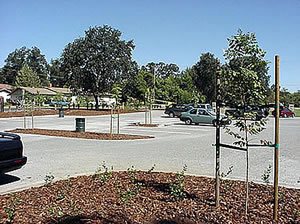
This parking lot installed in 2001 at Bannister Park, Fair Oaks, Calif., is the first in the state to use pervious concrete. The Sacramento Cool Communities program was a partner in the project, which used pervious concrete for stormwater management and to reduce the urban heat-island effect. In about 10 years, the trees will shade more than half the lot.
Concrete is a friend of the environment in all stages of its life span, from raw material production to demolition, making it a natural choice for sustainable home construction. Here are some of the reasons why, according to the Portland Cement Association and the Environmental Council of Concrete Organizations:
Resource efficiency. The predominant raw material for the cement in concrete is limestone, the most abundant mineral on earth. Concrete can also be made with fly ash, slag cement, and silica fume, all waste byproducts from power plants, steel mills, and other manufacturing facilities.
Durability. Concrete builds durable, long-lasting structures that will not rust, rot, or burn. Life spans for concrete building products can be double or triple those of other common building materials.
Thermal mass. Homes built with concrete walls, foundations, and floors are highly energy efficient because they take advantage of concretes inherent thermal massor ability to absorb and retain heat. This means homeowners can significantly cut their heating and cooling bills and install smaller-capacity HVAC equipment.
Reflectivity. Concrete minimizes the effects that produce urban heat islands. Light-colored concrete pavements and roofs absorb less heat and reflect more solar radiation than dark-colored materials, such as asphalt, reducing air conditioning demands in the summer.
Ability to retain stormwater. Paved surfaces tend to be impervious and can block natural water infiltration into the soil. This creates an imbalance in the natural ecosystem and leads to problems such as erosion, flash floods, water table depletion, and pollution. Pervious concrete is a special type of structural concrete with a sponge-like network of voids that water passes through readily. When used for driveways, sidewalks, parking lots, and other pavements, pervious concrete can help to retain stormwater runoff and replenish local water supplies.
Minimal waste. Concrete can be produced in the quantities needed for each project, reducing waste. After a concrete structure has served its original purpose, the concrete can be crushed and recycled into aggregate for use in new concrete pavements or as backfill or road base.
WHAT IS GREEN BUILDING, AND WHY DOES IT MATTER?
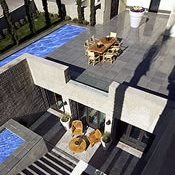
Concrete is the key building material used in The New American Home 2004. Erin OBoyle Photographics. Photo Courtesy of Portland Cement Association.
For most homebuilders and homeowners, expressions such as sustainable development, green building, and eco-friendly design werent part of the vernacular several years ago (although commercial builders have long been familiar with these terms). But with mounting concerns about rising energy costs and the continued depletion of finite resources, these environmental buzzwords are becoming mainstream.
In the past 10 years, green building has surged in popularity in the residential sector, according to Ray Tonjes, chair of the National Association of Home Builders Green Building Subcommittee. He says that more homebuyers are making environmental issues a top priority for new construction and remodeling.
Sustainability expands on the basic concept of reduce, reuse, and recycle. It seeks to balance sensitivity for the environment with economic and social values. For homeowners, the benefits of green living go beyond environmental stewardship. Sustainable homes also offer many practical, personal, and economic advantages including:
-
Lower utility costs.Through such strategies as proper site orientation, the use of insulating building materials, and tighter construction to reduce drafts, sustainable homes require much less energy to heat and cool. Sometimes off-grid energy sources, such as solar power, can be used to meet all or part of the homes electricity needs.
-
Reduced impact on the surrounding environment and community. Sustainable homes make more use of materials manufactured or harvested in an environmentally responsible manner. They also use materials available locally, not only to reduce transportation impacts (such as fuel consumption and pollution) but also to stimulate the local economy. Attention to landscaping is important as well, with consideration given to minimizing stormwater runoff, which can pollute local waterways.
-
A healthier, more comfortable living environment. By using nontoxic materials, sustainable homes have better indoor air quality. They also use materials resistant to moisture and rot to eliminate concerns about the growth of hazardous mold and mildew. Exterior walls typically have greater thermal mass, which offers the dual benefits of reducing temperature fluctuations and muffling outdoor noise.
-
Greater durability with less maintenance. Building with highly durable, low-maintenance materials, such as concrete, extends the useful life cycle of a sustainable home and reduces maintenance and replacement costs.
SOME SOBERING STATISTICS
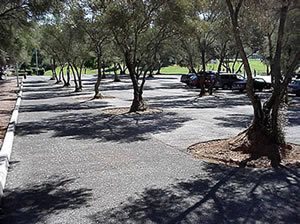
Fair Oaks, Calif., is helping to preserve over 23 mature olive trees through natural irrigation. The lush tree canopy also shades the parking lot to provide natural cooling. Tree roots need air as well as water. Pervious concrete allows the passage of both. This pervious parking lot at Miller Park in
Many homeowners are unaware of the negative impacts their homes and surrounding paved surfaces can have on environmental health. But the effects are dramatic, ranging from resource depletion to climatic changes to disruption of fragile ecosystems. Consider these disturbing facts:
-
With about 1.4 million homes built each year, homes represent 55% to 60% of all environmental impacts of buildings. (Source: USGBCs LEED for Homes Committee)
-
It can take over 40 trees to build one wood-framed home.(Source: PCA)
-
Operating a typical home or building over time consumes far more energy than it does to build it, according to Vera Novak, an environmental specialist and one of the ConcreteNetworks Industry Leaders. While investigating the life cycle of buildings, she found that a mere 2% of total energy is expended for materials and construction and a staggering 98% is used to heat, cool, and power the building.
-
Studies have shown that urban environments have higher temperatures in areas where there are few trees and lots of buildings and paved surfaces. This additional heat (called the urban heat-island effect) causes air conditioning systems to work harder, consuming up to 18% more energy.
-
Stormwater runoff is a leading source of the pollutants entering our waterways. According to the U.S. Environmental Protection Agency, about 90% of surface pollutants are carried by the first 1-1/2 inch of rainfall.
-
As much as 95% of the hydrocarbons in urban runoff is from the binder and sealer used in asphalt pavements.
WHY CONCRETE IS A HEALTHY ALTERNATIVE
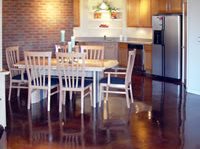
Clean environments, free of dust, mildew and other
pollutants can be achieved with interior concrete floors.
Photo Courtesy of the Decorative Concrete Institute.
On average, we spend 90% of our time indoors-and most of that time we are in our own homes, according to Angela Dean, author of Green By Design. Yet, we are increasingly using products containing volatile organic compounds (VOCs), in some cases creating indoor air quality that is 20 to 30 times more toxic than outdoor air, she warns.
The Healthy House Institute reports that indoor air pollution is the cause of about 50% of illnesses. Common sources of this pollution include outgassing from toxic paints and finishes, carpeting, manufactured wood products containing glues high in formaldehyde, dust mites, mold spores, mildew, and some cleaning products.
When it comes to poor indoor air quality, carpeting is one of the worst offenders. New synthetic carpeting can outgas over 100 different VOCs. And whether made of synthetic or natural materials, carpet is difficult to clean and becomes a haven for dust particles, pollutants, and bacterial growth. Tens of millions of microorganisms can be found in a square foot of carpeting. Carpet can also be a major source of mold, especially if it becomes wet and the water isn't removed completely.
Concrete floors, stained with nontoxic pigments, are a healthier alternative to carpeting because they do not emit harmful VOCs and are easy to sweep clean. In fact, VOC emissions from concrete building products are much lower than those for most other building materials, according to PCA. The use of natural lime-cement plaster wall finishes and concrete countertops can also significantly reduce total VOC concentrations inside a home.
Exposure to toxic mold in homes and buildings has been blamed for ailments ranging from headaches to severe respiratory infections and immune system disorders. Mold can thrive on any organic material, especially in warm, moist, humid conditions. In addition to carpeting, mold can feed on drywall and wood studs, joists, and wall sheathing. Concrete floors and walls won't support the growth of toxic mold.
WHERE TO LEARN MORE ABOUT SUSTAINABLE BUILDING WITH CONCRETE
U.S. Green Building Council: www.usgbc.org
Concrete Homes Council: www.concretehomescouncil.org
GreenHomeGuide: www.greenhomeguide.com
PCAs stucco page: www.cement.org/learn/materials-applications/stucco
